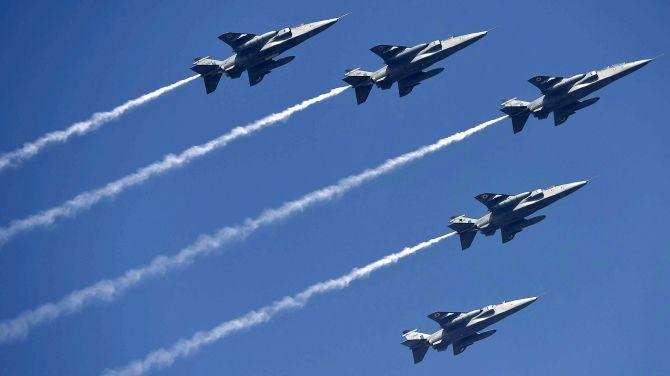 | « Back to article | Print this article |
With the IAF having rejected variants of 4 of the contending aircraft -- the Super Hornet, F-16, Gripen C/D and MiG-35 -- in flight trials carried out between 2009-2011 in the MMRCA tender, are the current contenders improved enough to pass flight trials conducted to the same standards?
Ajai Shukla reports.

Six of the world's premier fighter aircraft vendors -- American companies Boeing and Lockheed Martin, Russian Aircraft Corporation, Dassault of France, Swedish firm Saab and European consortium, Eurofighter GmbH -- have submitted responses to an Indian 'request for information' (RFI), kicking off the purchase of 110 fighters for the Indian Air Force.
The IAF had put out a detailed, 73-page RFI on April 6, giving 'original equipment manufacturers' (OEMs) and 'government sponsored export agencies' three months to submit their responses. Friday, July 6, was the last date.
There are four twin-engine aircraft in the fray: The F/A-18E/F Super Hornet, Block III, Eurofighter Typhoon, MiG-35 and the Rafale.
Two single-engine fighters have been offered: The F-16 Block 70 and Gripen E.
The flyaway cost of single engine fighters is estimated to be between $80 million and $90 million, with the larger, twin-engine fighters likely to be priced at $120 million to $160 million, according to industry analysts.
The RFI mandates that 85 per cent of the fighters must be built in India, and each of those would cost at least $20 million more.
That adds up to an overall contract price of $10.66 billion for the cheapest single-engine fighters, to $19.46 billion for the high-end, twin-engine fighters.
The cost of weaponry, spares, base infrastructure and simulators would be over and above that.
The defence ministry will now process the acquisition under the provisions of the Defence Procurement Procedure of 2016 (DPP-2016).
The RFI leaves the door open for an Indian private sector firm to co-manufacture the selected fighter in India.
The next stage of procurement will involve scrutinising OEMs' responses to the RFI to assess the options available.
Based on vendors' responses, the IAF would draw up a short-list of vendors that would receive the IAF's 'request for proposals', or formal tender, spelling out its precise requirements, the terms and conditions of supply, Make in India and offsets.
In response to the RFP, the OEMs will submit two simultaneous bids: First, a technical bid, with details of aircraft performance, terms of supply, technology transfer and Make in India proposals.
Alongside that, OEMs would submit their commercial bids, which would indicate the cost the IAF would have to pay.
The RFP will indicate whether the commercial bids would be assessed on the basis of the upfront price, or through 'life cycle costing' (LCC).
The latter involves totting up the total cost of ownership, including the cost of flying and maintaining the fighter through its 3-4 decade-long service life.
While LCC better indicates the real price the IAF will pay for a fighter, it is a complex calculation that led to disputes and the eventual abandonment in 2015 of the 2007 RFP for 126 medium, multi-role, combat aircraft (MMRCA).
The RFP will indicate whether the IAF follows the same path.
Another question hanging over the current fighter procurement is: With the IAF having rejected variants of four of the contending aircraft -- the Super Hornet, F-16, Gripen C/D and MiG-35 -- in flight trials carried out between 2009-2011 in the MMRCA tender, are the current contenders improved enough to pass flight trials conducted to the same standards?
If not, the IAF would have to lower its performance bar during flight trials, or face the same outcome, in which only the Typhoon and Rafale were found technically eligible.
What the air force wants